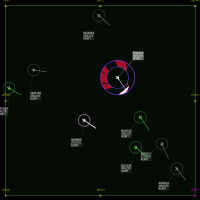Studying factors underlying automation acceptance.
The first MUFASA project provided empirical evidence that both acceptance and strategic conformance are important human factors issues in ATM that have the potential to determine automation use. In the end, one result stood out in particular: of 256 conformal solutions (i.e. replays of controllers’ very own previous performance), 61 (or 23.8%) were rejected by controllers. How is it that controllers would disagree with themselves nearly one quarter of the time? One speculation is that controllers are simply inconsistent over time in the solution and strategy they might choose to employ. Alternatively, it could be that controllers are not necessarily opposed to automation per se, but to advisories from any source (even, say, from a colleague).
These and other remaining questions lead us to a small extension of the MUFASA project, to explore three interesting research topics:
- Transparency (T)—does automation transparency impact acceptance or agreement?
- Consistency (C)—are controllers internally consistent in their resolution strategies over time?
- Source Bias (S)—are controllers biased against automation per se, or against any external source of advice? Would they show a similar level of bias against a presumed human advisor as against a presumed machine advisor?

